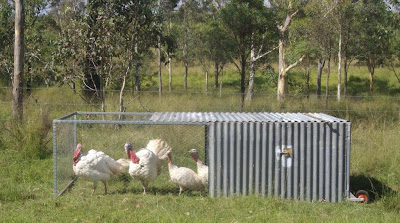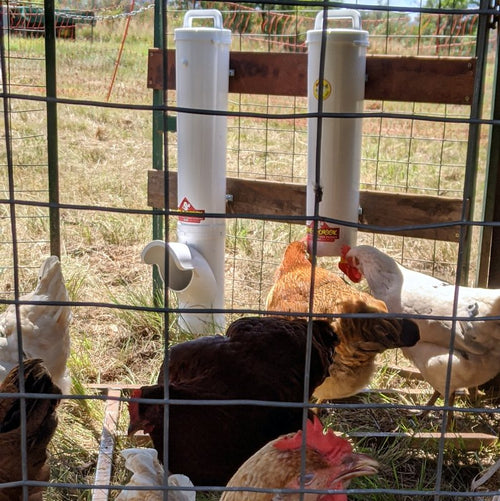How to build a chicken tractor
Chicken tractors are a great alternative to fixed chicken pens if you want to be able to move your chickens around on fresh pasture, while providing protection against predators. My eBook A Beginner's Guide to Backyard Chickens and Chicken Tractors has more detail about chickens and chicken tractors. Get your copy here.
Chicken Tractor Construction Materials
Chicken tractors can be constructed from many different materials, but with Pete being a welder, our material of choice is always metal. All the tractors are built using "box section", metal mesh and roof sheeting.
I've seen tractors made from wood (very good example here) and from poly pipe, so if you're not into metal, then there are plenty of other options. You can also size them to fit on your garden beds or between rows in an orchard to till the soil and catch bugs. If you make them from light material they will be easier to move.
 |
Look for materials that are cheap or free
We got the roll of mesh for our first tractors at a closing down sale, and sized the tractors to fit the mesh. All the roof sheeting has been second hand from demolition yards and the box section is "down grade" (which means its a little warped or defective). Some of the wheels were bought new, but others have come from an old cart, a BBQ trolley and from the dump shop (old mower wheels).
For some of the tractors we cut down sapplings to use as the roosting pole. For one of the small tractors, Pete welded in a shelf from an old fridge instead of the pole, so the wee ones can all hop up onto the shelf to sleep. The size and shape of your tractor will depend on the materials that you can source. We also made the larger tractors to fit onto the car trailer, so that they can easily be moved, and it was lucky we did, as we moved about 200km not long after we built them.
How many doors does a chicken tractor need?
Most of our tractors have two doors, one large door for the chickens to get out to free-range, or for us to crawl in and catch them when necessary. The other, smaller, door is for refilling food and collecting eggs. You will also need hinges and catches for the doors, but these don't need to be complicated, one of ours broke recently, so I just use some wire to secure the door now. On the last large tractor we made, we only used one door to save on materials, if you are clever about where to put everything, you can get away with one door.
 |
Nesting Boxes for Chicken Tractors
All the tractors have some kind of nesting box. The best ones in the large tractors are made from folded sheet metal, and were made when Pete had access to a metal folder. They have been good as they are easy to keep clean and there's nowhere for mites and lice to hide (which can be a problem with wooden boxes).
In the tractor we made more recently, we just cut a section out of an old 20 L jerry can to produce a nesting box and screwed it into the wall of the tractor. Another box has an old wooden box with a section cut out so that the chicken can get inside. I've also seen old mower grass catchers used, so visit the dump shop for inspiration if you don't have anything suitable at home already!
Chicken Tractors need shade
We found that the chicken tractors got too hot in summer, and its hard to have them parked under a tree all the time, when the purpose is to move them, so we clipped shade cloth onto the mesh at the top to keep the tractors cool. This blocks the midday sun, but the chickens can still enjoy morning and afternoon sun.
 |
| this one only has one door at the back |
We have painted our two large tractors, because it took us several weekends to build them, we wanted them to last, with the other ones we've been a bit slack about painting (as they needed to be occupied right away!) and they remain unpainted, but its on the list! We filled all the holes in the roof sheeting with silicon to make sure that they wouldn't leak.
Chickens Tractors are good for properties of any size
Our chicken tractors have been perfect for our needs and would suit any small acerage property that had a bit of flat land (and the small ones would work in a normal house block), but now that we have a larger property and would love to one day keep pastured poultry to clean up after our cattle (a la Joel Salatin) one day soon we will be designing new chicken tractors on a larger scale. Our experience with small tractors for 3-10 chickens will help us to make something that can house 100 chickens.
| shade cloth clipped on the top mesh |
How we built our last chicken tractor
Our first large tractors took 3-4 weekends to build, with the doors and wheels being particularly fiddly, this one took only half a day for Pete to cut and weld the frame and then another day with me "helping" to finish it off.
Decide on the size of the chicken tractor
| frame - note handle at the top front |
| door |
| overlapped frame for wheel attachment (and bolt for attaching the wheel) |
Roofing iron for the chicken tractor
We had the choice of either iron that was left over from re-roofing our previous house, or the old iron that was on the roof. I was embarrassed to see the terrible condition of the old iron, can't believe it was on the roof, rusty and full of holes! We decided to use the new iron because it is lighter, has no holes to be filled and is zinc-alum so wouldn't need painting, it was the quick and easy option. The old iron will be used for something, don't worry!
For previous tractors we have used old iron sourced from demolition yards or dump shops, it just needs to be wire brushed, holes filled with silicon and then painted to keep it in good condition.
| The old roof (back) or the new rood (front)?? |
Mesh for the chicken tractor
| Tek screwing the iron in place, we folded it around the corners to save time on cutting |
| The wheels mounted on bolts welded to the frame |
| The finished door, very flash, ended up like this because that sheet of iron was a little short and we had some left over weld mesh from the dog box! |
| A bar welded about halfway along the top of the frame is used to support the roof and to hang the feeder |
| We attached the mesh by weaving through thin "tie wire" using a bobbin |
 |
| This is how the bobbin works, the wire pulls very tight. |
| The tractor is heavy, but can be moved easily using a trolley |
| And here is the finished product |
| approved by Bella |
Do you use chicken tractors? What are they made out of and how to you build the? Any clever ideas?
| How to build a chicken tractor |
| How to use a chicken tractor |
| Chicken tractors vs fixed pens |
| Why you should consider using chicken tractors |
My eBook A Beginner's Guide to Backyard Chickens and Chicken Tractors has more detail about chickens and chicken tractors. Get your copy here.























Leave a comment